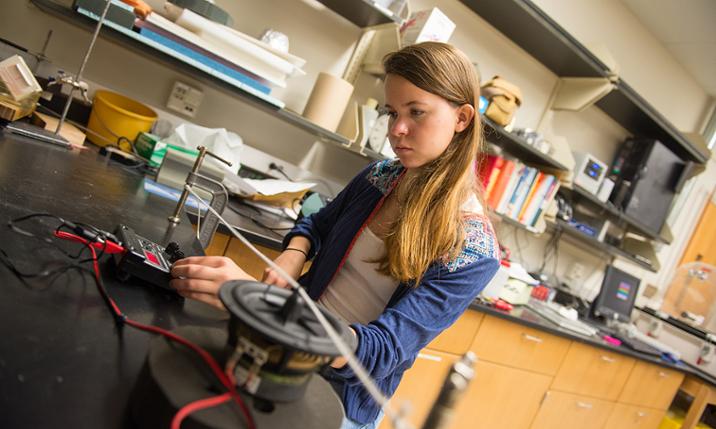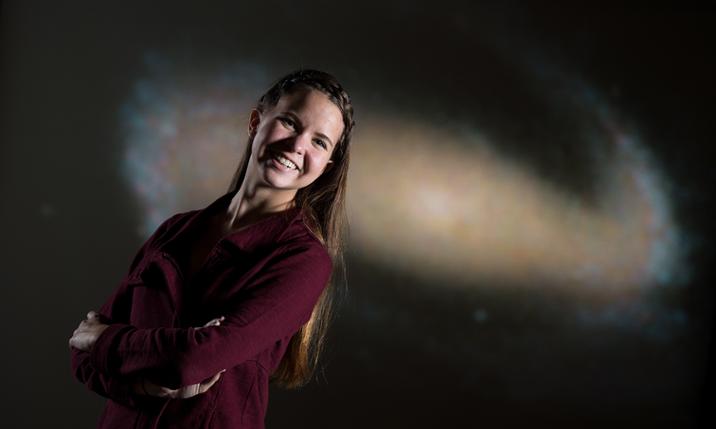Finding out what's at the end of the universe
Science and Technology
How do you get a head start on graduate school? Physics major Emily Dick ('16) has a plan.
By Meaghan MacDonald ('13)
From Winter 2014 Madison magazine
Physics majors are in high demand across the job board, whether it’s engineering, graduate school, medical school or working for companies. Sophomore Emily Dick (’16) credits the appeal of physics majors to their never-ending quest to both ask questions and to make connections of the unknown to the known.
“You have to justify the connections that you are being taught,” Dick says. “You can see the equation, but unless you understand why and how to get there, you’re not going to remember it. And you’re not going to know why it’s like that. … Making those connections really helps things stick.”
Dick says that professors who teach the fundamental skill of “making connections,” and JMU’s small class sizes, are two things that drew her to the JMU physics and astronomy program. A local student from Broadway, Va., Dick says a physics major — and even JMU — were not her first choices until she visited campus and met professors in the JMU Department of Physics and Astronomy.
'JMU is unique in that it gives all undergrads the opportunity to work in the labs as soon as their sophomore year.'
"I visited all my other college choices, but after I toured JMU, I knew I wanted to come here.”
Dick was accepted for admission at the College of William & Mary, Christopher Newport University and Embry-Riddle Aeronautical University. She also made the interview round at Princeton University which, she says, “was an honor. However, the name of a university isn’t enough to base a final college decision on,” explains Dick, who also is a JMU Second Century Scholar. “Most of these universities have graduate schools that give graduate students first choice of all the research laboratory positions. But, JMU is unique in that it gives undergrads the opportunity to work in the labs as soon as their sophomore year,” she adds. “This really appealed to me.”
Gaining the advantage
Dick, who plans to study astrophysics further after graduation, was one of three undergraduate students to complete active galactic nuclear research with Anca Constantin, JMU physics and astronomy professor. The summer 2013 research was part of a $10,000 grant from the Jeffress Memorial Trust to continue Constantin’s project — finding water megamasers suitable for measuring distances from Earth to the galaxies they reside in and for measuring the mass of these galaxies’ supermassive black holes.
For the whole history of astronomy, we wanted to get estimates of these,” says Constantin, who is part of the National Radio Astronomy Observatory’s Megamaser Cosmology Project. “We do have some other methods for weighing supermassive black holes, but this method gives us the most accurate estimate on how massive they are.”
JMU Physics and Astronomy Professor Shanil Virani says, “JMU physics and astronomy undergraduate students get to complete hands-on research early in their academic careers and this makes them more marketable. It also gives them an advantage for their futures careers in physics and in their continued educational careers.”

Learning collaborative skills
Dick plans to pursue both a master’s and doctorate degree, and says she feels she has a “head start” on graduate school because of her JMU undergraduate research experiences.
“My mom says when I was 4, I asked her what was at the end of the universe,” Dick says. “I was always thinking about it. I always loved math and science, and I like figuring out stuff for myself, so physics was a perfect choice. Now, working with Dr. Constantin this summer, I have been studying black holes at the far reaches of the universe — hands-on research looking beyond my 4-year-old imagination!”
Dick also likes the collaborative nature of physics and astronomy studies. “Answering science’s greatest questions is up to everyone — all fields of study. When people think of physicists, like Albert Einstein, those are the great leaps and bounds everyone needed to make. But now, it’s going to be everybody working together to figure stuff out. We already have the equations; we just have to analyze things and discover more.”
Learn more about Constantin and Dick’s megamaser research.
